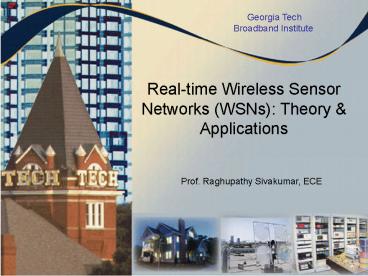Real-time Wireless Sensor Networks (WSNs): Theory - PowerPoint PPT Presentation
1 / 7
Title:
Real-time Wireless Sensor Networks (WSNs): Theory
Description:
Georgia Tech Broadband Institute Real-time Wireless Sensor Networks (WSNs): Theory & Applications Prof. Raghupathy Sivakumar, ECE – PowerPoint PPT presentation
Number of Views:359
Avg rating:3.0/5.0
Title: Real-time Wireless Sensor Networks (WSNs): Theory
1
Georgia Tech Broadband Institute
Real-time Wireless Sensor Networks (WSNs) Theory
Applications
Prof. Raghupathy Sivakumar, ECE
2
Objectives
- Design and develop algorithms, protocols, and
systems for real-time and mission-critical
communication in WSNs - Three main challenges addressed timeliness,
robustness, correctness - Four complimentary goals
- Higher capacity
- Lower energy consumption
- Information Prioritization
- Reliable communication
- Demonstrate research through test-bed and
real-life applications
3
Team Funds
- 11 Members
- Raghupathy Sivakumar (Fac)
- Umakishore Ramachandran (Fac)
- Faramarz Fekri (Fac)
- Mary Ann Ingram (Fac)
- Sandeep Kakamanu
- Sriram Lakshmanan
- Rajnish Kumar
- Junsuk Shin
- Badri Narayanan
- Nazanin Rahnavard
- Lakshmi Thanayankizil
- Other Sources of Funds
- Heterogeneous WSNs
- NSF ITR, NSF REU
- Securing WSNs
- Navy
- Multi-channel WSNs
- NSF NOSS
- WSNs with smart antennas
- NSF CCR, NSF NOSS
- Multi-scale unreliable sensor networks
- NSF NOSS
(650K total funding in 2006-2007)
4
Solutions
- Information Prioritization Real-time
Prioritization algorithms Multi-sensor
peer-to-peer fusion Increased timeliness - Opportunistic Large Arrays Cooperative
transmissions Simple amplify and forward
Increased range, and battery power - Reliable Broadcast using Fractional
Transmissions Hybrid coding and routing
Lightweight rate-less coding Increased
reliability - Component based Multi-channel allocation Single
channel component level operation Optimal
performance with key practical benefits
Increased capacity
5
Applications
Medical (patient monitoring)
Security (digital surveillance)
Video (video over IP)
Wireless (channel management)
6
Real Time Sensor Networks challenges and
solutions
- Objective
- Reduces transmissions without sacrificing
reliability - Motivation
- An opportunistic large array (OLA) is a form of
cooperative diversity where simple,
single-antenna nodes transmit together in
response to a source or another OLA - OLA state of the art uses flooding. While MAC
and routing overhead is eliminated for single
messages, more energy can still be saved - Proposed schemes
- OLA-T (OLA-Threshold) a threshold will be
applied to the received power to determine if the
node should repeat. Saves about 50 of the energy
when compared to whole network flood - OLACRA (OLA Concentric Routing Algorithm) -
Upstream routing suitable for SNs. Saves about
60 of the energy in comparison with whole
network flood, while maintaining connectivity
- Objective
- Efficient data gathering from sensors in
wireless sensor networks - Efficient data broadcasting in multi-hop
wireless sensor networks - Motivation
- Gathering data from image sensors with
correlated data - Updating software in already deployed
sensor/actuator networks - Proposed schemes
- Date gathering Scheme Distributed Source Coding
(DSC) - Broadcasting Schemes
- No information about the network topology is
available Collaborative Rateless Broadcast
(CRBcast) a two-phase data dissemination
algorithm employing rateless coding and
probabilistic broadcasting in the first phase and
a local recovery in the second phase - Local information about the network topology is
available Fractional Transmission Scheme (FTS)
employs rateless coding to make it possible for
the nodes to send just a fraction of data
- Three main challenges of real-time sensor
networks - Timeliness
- Reliability (Packet level)
- Correctness (Application level)
- Objective
- Using multiple channels for throughput
enhancement of wireless sensor networks with low
complexity - Motivation
- Channel assignment in multi-channel wireless
networks can increase achievable throughput by
overcoming the problems of interference, varying
channel characteristics, poor end-to-end
characteristics - At any given time a node with a single radio can
operate on only one channel - No hardware/MAC changes, no switching delay, no
synchronization requirement, and no scheduling
overheads - Proposed schemes
- We introduce a new model for channel assignment
known as Component-Based where all links in a
connected component induced by the underlying
flow graph operate in a single channel - Although the component based model looks simple,
we show that this model can have equal if not
better performance over link and flow based
approaches
- Objective
- Right information at the right time
- Motivation
- Moving from a centralized to a distributed
solution - Increase Information-Awareness
(Cognitive-Awareness) - Information Prioritization and Fidelity
Adjustment - Proposed Scheme
- ASAP Architecture
- Separate data and
- control network
- Priority-aware
- transport
- Using multi-modal
- sensing to do prioritization
- Application 1
- IPTV enhancement using WSN.
- Application 2
- Video surveillance application with
information prioritization
- Application 3
- Wireless mesh network management
7
Aware-home User-aware IP Video Delivery































